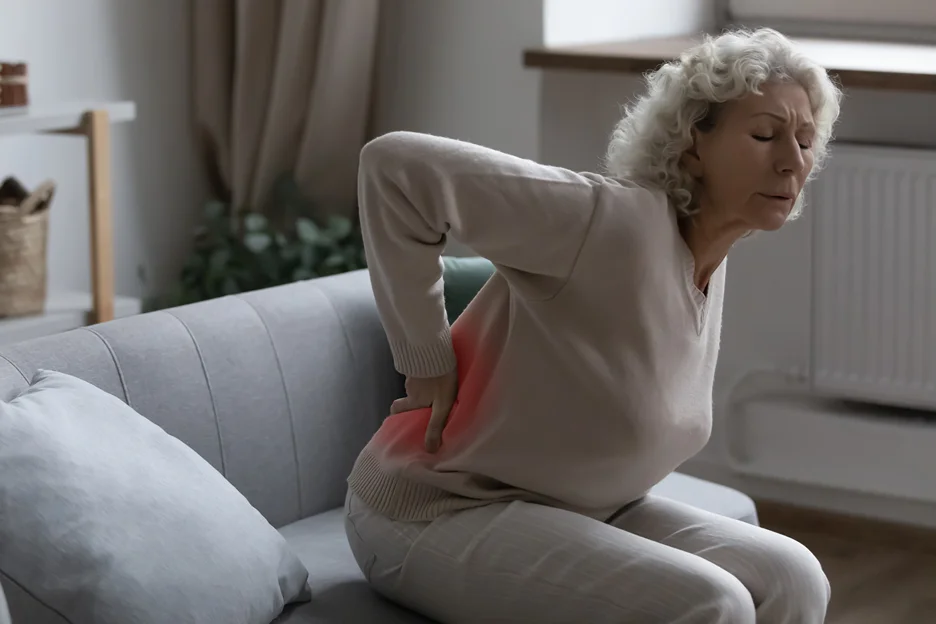Navigating Sciatica and Osteoporosis Care: Let Kaly Be Your Guide
At Kaly, we understand that chronic health conditions like sciatica and osteoporosis can greatly impact quality of life. Many of our patients experience both sciatic nerve pain and weakened bones, leading them to ask – is there a link between sciatica and osteoporosis? The short answer is yes. Let’s explore the ways these two conditions interconnect.
Sciatica refers to pain, weakness, numbness or tingling along the sciatic nerve, which runs from the lower back down through the buttocks and legs. It is often caused by a herniated or bulging spinal disc pressing on the sciatic nerve roots. Osteoporosis is a disease characterized by low bone mineral density and deterioration of bone tissue, making bones fragile and prone to fracture.
There are several reasons why sciatica and osteoporosis tend to co-occur:
- Age – Older adults are more susceptible to both conditions. The natural degeneration of spine discs and bone loss from aging contributes.
- Reduced mobility – Difficulty walking and activity avoidance from sciatica pain can accelerate bone loss.
- Vitamin D deficiency – Inadequate vitamin D negatively affects bone strength and nerve health.
- Medications – Certain drugs used for treating sciatica and osteoporosis have side effects that can impact the other condition.
- Trauma – Falls or injuries resulting from weak bones can damage spinal discs and nerves.
- Structural changes – Vertebrae fractures and height loss from osteoporosis can increase pressure on the sciatic nerve.
How Osteoporosis Increases Your Sciatica Risk
Let’s look more closely at how osteoporosis increases the risk of experiencing painful sciatica:
As bones weaken, vertebrae are at higher risk of compression fractures and collapse. This causes a change in the structure of the spinal column, reducing space between the vertebrae.
Narrowing of the spinal canal and openings for the sciatic nerve puts more pressure on the nerve and surrounding discs. The added pressure leads to inflammation and irritation of the sciatic nerve, causing those sharp, shooting pains.
Osteoporosis and Dowager’s Hump Connection

Osteoporosis also leads to height loss and curvature of the spine, called hyperkyphosis or “dowager’s hump.” This misalignment and added spinal pressure can cause discs to herniate more easily into the sciatic nerve space.
Additionally, when the vertebra shifts position due to fracture, it may impinge the nerve roots or supportive ligaments. Any of these spinal changes from osteoporosis can contribute to developing debilitating sciatica symptoms.
Kaly’s Holistic Approach to Sciatica and Osteoporosis Care

At Kaly, we recommend patients experiencing both conditions work with physical therapists and osteopaths for optimal treatment and pain relief. Therapy focuses on gentle strengthening and stability exercises to improve posture, take pressure off compressed nerves, and support the spine. Techniques like nerve flossing and manual spinal adjustments are used to create space around impinged nerves.
Your care providers may also prescribe medications to ease nerve pain and slow bone loss. Some supplementary approaches include vibration platforms to stimulate bone growth and dietary changes to reduce inflammation. Surgery for severe herniated discs causing sciatica may be an option after exhausting nonsurgical treatment.
While a diagnosis of osteoporosis does not always guarantee sciatica will develop, individuals with osteoporosis should stay on alert for any of these common signs of sciatic nerve compression:
- Burning, sharp pain in buttocks and leg
- Lower back pain and spasms
- Numbness or tingling down the leg
- Muscle weakness making it hard to stand on tiptoes
- Stabbing thigh and calf pain when sitting that eases with walking
If you have osteoporosis and notice these sciatica symptoms, do not ignore them. Seek medical attention to assess your spinal health and prevent further deterioration. The sooner you can start treatment, the better your chances of managing pain and protecting your mobility.
At Kaly, we guide our patients to make informed health decisions. If you are dealing with both osteoporosis and sciatica, let our trusted providers find the ideal specialized care to alleviate your pain and get you thriving again. We will get you on the right treatment path so you can continue enjoying all that life has to offer.
Frequently Asked Questions on Sciatica and Osteoporosis
Can osteoporosis lead to sciatica?
Yes, osteoporosis can contribute to sciatic nerve pain. Weakened vertebrae, fractures, and posture changes from osteoporosis increase pressure on the sciatic nerve, often causing it to become pinched or inflamed.
What is the link between low bone density and sciatica?
Deteriorating bone tissue from conditions like osteoporosis causes structural changes in the spine that narrow the canal surrounding the sciatic nerve. This added pressure on the nerve can lead to sciatica symptoms.
Why does osteoporosis raise the risk of a herniated disc?
Weakened vertebrae are at higher risk of fractures and abnormal curvature, which adds more pressure to spinal discs. This makes it more likely for a disc to rupture or herniate into the sciatic nerve space, causing irritation.
Can losing height due to osteoporosis contribute to sciatica?
Yes, height loss from collapsed vertebrae reduces space between discs, compressing the sciatic nerve. It also leads to dowager’s hump, which misaligns the spine and contributes to disc herniations onto the sciatic nerve.
If I have severe osteoporosis, does that mean I will develop sciatica?
Not necessarily. While osteoporosis raises the risk of sciatic nerve compression, not everyone with weak bones will develop painful sciatica symptoms. Those with both conditions should work closely with medical providers to manage symptoms.
What treatments are used for people with sciatica and osteoporosis?
Physical therapy, osteopathic manipulation, nerve flossing exercises, pain relievers, calcium supplements, and sometimes surgery are used to treat both issues simultaneously. Lifestyle changes like diet, gentle exercise, and posture aids also help.
Can medication for osteoporosis make sciatica worse?
In some cases, yes. Medications like bisphosphonates used for osteoporosis can cause bone or joint pain as a side effect, potentially exacerbating sciatica and low back pain symptoms. Doctors monitor this closely.
How does vitamin D help both osteoporosis and sciatica?
Vitamin D is critical for bone health and nerve functioning. Adequate vitamin D reduces bone deterioration while also decreasing sciatic nerve inflammation and pain signals.
Can an osteoporosis-related fracture require sciatica surgery?
It’s possible. If an osteoporotic spinal fracture severely impinges or compresses the sciatic nerve, surgery may be required to remove bone fragments or discs irritating the nerve if conservative treatment fails.
What exercises help strengthen bones and relieve sciatica?
Low-impact, spinal stabilizing exercises like Pilates, yoga, and core training help build bone density while improving posture and flexibility to take pressure off the sciatic nerve.
